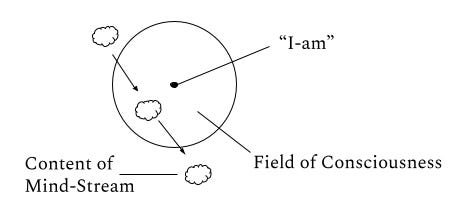Dissociation vs. Disidentification
Understanding the Power in Observation over Denial
When I first discovered the concept of dissociation I experienced a radical shift in my perception of self. Identifying and labeling a process that was perpetuating the wounding of early childhood I could finally get a grasp on how my sense of self was fractured. Dissociation is one of the most important concepts to understand when processing your inner wounds. It is an underlying thread in many people's lives yet goes completely unnoticed or worse, is deemed insignificant. In this article we will dive deep into the meaning of what dissociation is as well as how to consciously overcome this inner splitting.
Dissociation is a general response to trauma. It is the clap of thunder that follows the lightning strike of pain too great for the ego to handle. However, unlike thunder, dissociation lingers like a thick fog until we are able to become consciously aware of it. Whenever we experience reality before our mind can visualize and digest it our psyche splinters, repressing painful feelings that if consciously felt would only lead to more wounding. This ultimate wound is the threat of nonbeing. This threat of non-existence runs deeper than our threat of physical death. This is an ancient survival mechanism built into the core of our being.
Dissociation also has parallels in the body. Looked at empirically we can see the various states our nervous system will go through when faced with imminent danger. These are the classic “flight or fight” responses that are evident in most creatures. One of the most prominent nervous system responses when faced with trauma and fear inducing situations is the freeze response. The freeze response is characteristic of shutting the body down or in other words, going into paralysis and fear based immobilization. When this occurs the physical, visceral, bodily experience is shut out of conscious awareness. The body literally stiffens, forcing awareness to remain cut off in the head.
In the wild, animals go into a state of lifelessness when faced with imminent death. The rabbit who is standing directly before the wolf's bared fangs will experience a complete collapsing of muscles and a wash of numbness that prepares the creature for death. This wash of numbness or put simply, dissociation, allows the creature to perceive what is happening to it from an outside perspective. No longer identifying with the body the mind is free to think clearly, and this sudden lucidity may just save the organism's life. In addition, time dilates and slows down giving the animal a heightened ability to look for an escape. This becomes an issue only when the organism has no way of naturally coming back into their body. When this is the case, the dissociative state becomes chronic.
Our modern western society demands we digest much of the world before we are ready to. We are stifled with information pertaining to death and poverty while pornography and violent media lie accessible to anyone with a computer. Frequently we are taught to disregard the natural feeling cues emanating from our body. Schools are the biggest culprit, perpetuating an agenda of body disavowal by forcing young children to eat at certain times, not use the restroom when they need to, and to sit still in a room when their body is aching to move around. It is no wonder dissociation is embedded into the core of our culture.
One can only use the mind by tuning out the body. Notice what your body is doing when engaged in deep thought. There is either completely unconscious rote movement or a catatonic stillness as attention is entirely directed to the mind. Despite the wealth of scientific knowledge and insight we have gained from the age of enlightenment onward, we do not exist because we can think (sorry Descartes). Thinking is the tail end of a series of nervous system signals that we receive. We prepare to move, act, sense, feel, perceive, reflect, and then think. Secular society has reversed this and placed thinking on top.
When we overwhelmingly place emphasis on one aspect of the human experience we have dissociated from the rest. Placing all our credence on the mind, on thinking, rationale, vision, and above all image, has dissociated us from the primal, sensate, and visceral experience of the body. Of course, one can be dissociated from any mode of consciousness. Someone who identifies more with their body may be more impulsive and prone to chasing pleasurable felt experiences. In this instance attention is still on an image of perceived pleasure, taking place first and foremost in the mind. Nonetheless, dissociation has occurred and part of the personality has been repressed to the subconscious.
This is where the preeminent concept of disidentification comes into play. Dissociation is repression, an unknowing disavowal of part of the personality and experience of reality. However, it is only possible when the ego has become identified with one mode of consciousness over another. For example, someone who has dissociated from their feeling-body has identified with their mind, thinking, and cognition itself. This identification perpetuates the dissociation.
So how do we remedy our issue of dissociation? A part of the answer lies in disidentification. As Donald Kalshed mentions in his book, Trauma and the Soul, the prefix Dis- is used to describe various forms of psychological splitting. It in effect denotes a negative experience. Indeed, just as a negative number multiplied by another negative number produces a positive one, disidentification aids us in our dissociation. In order to understand this more clearly, let’s discuss a transpersonal view of the self.
When we sit and observe what we are doing we will eventually notice that despite our direct experience with the external world we still observe it from a removed origin of self. A distinct I-amness. The same is true for internal sensations. Our thoughts float through our mind while our feelings surge through our body. However, throughout all of this we are able to remain in a witness consciousness, or from a sense of self that transcends the immediate direct experience of mind and body.
In their book, The Primal Wound, John Firman and Ann Gila describe this visually. Imagine that your removed sense of I-am is a singular dot in the middle of a larger circle. This larger circle is your entire field of conscious awareness. From the vantage point of the center objects may come into your field of awareness or emotions and thoughts may enter from within as well. However, they will always pass through and your core sense of self will remain detached from them.
This state of I-amness is critical as from here we can be both engaged and separate from the contents that pass through our field of consciousness. The nature of I-amness is both immanent, meaning it is one and the same with, while simultaneously being transcendent from it. It has a quality described by Firman and Gila as being transcendent-immanent. Centering into this state greatly aids us in working through our identifications and painful emotions as we can effectively relate to and transcend them.
While non-attachment to any particular mode of consciousness is important it would be equally as destructive to remain totally passive and observant. Disidentification allows for us to have better control over where our attention can flow. When we are able to return to our original state of I-amness and disidentify from one mode or another we can begin to cultivate a higher degree of personal will. Personal Will is a term coined by a key thinker in the realm of transpersonal psychology, Robert Assagioli. Personal will is opposed to willpower, which attempts to dominate various aspects of the personality (resulting in dissociation of the dominated parts). Personal will is a byproduct of disidentification. When we are aware of the various aspects of self and are not purposefully suppressing or unknowingly repressing them, we can choose where to delegate our conscious attention. This ability to choose is our paramount tool in healing our inner wounds.
This has a paradoxical effect whereby the ability to choose when to willingly engage with a mode of consciousness helps us utilize that mode more efficiently. For example, many people today who are overidentified with thinking will “think” at the wrong times. They will be totally consumed by events that have yet to pass and thus remain in a chronic state of worry. When we can learn to recenter ourselves we can choose the appropriate time to engage our intellect and more importantly can see the underlying emotion that is really guiding our incessant worrying.
This is important as at times in life dissociation is indeed necessary. It is a mechanism designed to save your life. Hopefully with the correct tools we can learn to enter and exit this state under intentional control. It is this intention that matters most in the healing process. In the end we have immense power over how and where our awareness is directed. We don’t have to live in the chains of unwarranted dissociation.
Though the practice of disidentification can be useful for re-writing one’s personal narrative and reclaiming repressed parts of the personality, it is merely one step in healing our fractured psyche. The dissociated body still holds many painful emotions that must be eased into slowly. Through self-awareness we can begin to peel back the layers of our survival personality and begin to reintegrate what we were forced to dissociate from.
- Recommended Reading -
Trauma and the Soul by Donald Kalshed
In an Unspoken Voice by Peter Levine
The Primal Wound by John Firman and Ann Gila
If you liked this post, subscribe to Archetypical below!
If you know anyone who may like this post, please share it with them:
You can also support my work with a donation:




